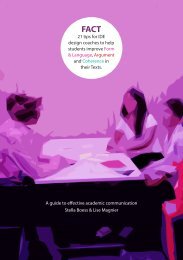Final Fact 18 march incl pics anders
You also want an ePaper? Increase the reach of your titles
YUMPU automatically turns print PDFs into web optimized ePapers that Google loves.
evidence<br />
<strong>Fact</strong>s that support<br />
the claim: research<br />
results<br />
“given that“<br />
warrant<br />
Reasons (rules, principles)<br />
connecting<br />
evidence and claim<br />
(“because“/<br />
“due to“)<br />
backing<br />
Reasons/evidence<br />
for the warrant<br />
(some, implicit)<br />
(”if”/“as long as”)<br />
limitation<br />
Limits of the validity<br />
of the claim:<br />
when it holds true<br />
“therefore“<br />
claim<br />
The statement<br />
being argued.<br />
Types: see Tip 12<br />
(“unless”)<br />
rebuttal<br />
Circumstances<br />
when the claim<br />
does not hold true<br />
Figure 5. The Toulmin model of argument.<br />
Example<br />
This text is an example of a well-supported argument<br />
(based on the Toulmin model).<br />
“To improve the break experience for students in the<br />
library, different interactions could evoke emotions<br />
and thus yield a potentially engaging experience<br />
(Bødker, 2006) (backing). The controllable nature<br />
installation I built in the university library is an<br />
example of providing such engagement: it engages<br />
students socially (claim). In a test of the installation,<br />
students mentioned feeling in control and enjoying<br />
the social experience (evidence). The installation thus<br />
has the effect of evoking the emotion of relief from<br />
the students’ thinking tasks (warrant), facilitated by<br />
control and sociability – if they have access to it and<br />
to other students (limitation), and unless they stay<br />
fixated on their digital devices during their breaks<br />
(rebuttal).”<br />
A GUIDE TO EFFECTIVE ACADEMIC COMMUNICATION<br />
53



